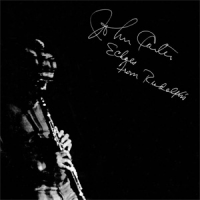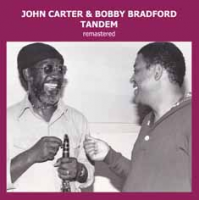Home » Jazz Articles » John Carter
Jazz Articles about John Carter
The Boyé Multi-National Crusade For Harmony

by Stefano Merighi
Che trionfo per Julius Hemphill! A dispetto delle poche pagine--o righe--che le recenti storie del jazz dedicano al maestro di Fort Worth, Hemphill emerge da questo cofanetto di inediti come sassofonista-improvvisatore-compositore tra i più profondi della musica afroamericana nei decenni compresi tra gli anni '70 e '90. E questa preziosa edizione non solo torna a far luce su repertori e organici già conosciuti dai cultori, ma porta in superficie una gran mole di musica fresca, sorprendente, che ...
read moreJulius Hemphill: The Boyé Multi-National Crusade For Harmony

by Mark Corroto
There is something inherently objectionable when a billionaire acquires an artistic masterpiece by say, Leonardo DaVinci or Claude Monet, only to sequester it from public view. You might feel the same about Julius Hemphill's recordings Dogon A.D. (Mbari, 1972) and 'Coon Bid'ness (Arista/Freedom, 1975). Both five star recordings, now out of print, cost a small fortune to acquire. Years ago saxophonist Tim Berne, a disciple of Hemphill, endeavored to rescue the saxophonist's Blue Boyé (Mbari, 1977) by rereleasing it in ...
read moreRoberto Miranda's Home Music Ensemble: Live at the Bing Theater; Los Angeles, 1985

by Karl Ackermann
Roberto Miranda has appeared on almost one-hundred albums but has been lightly recorded as a leader, and inexplicably struggled to generate interest among labels. Dark Tree Records has released some great Horace Tapscott performances from the '70s and '80s. The label resurrected a Miranda-led session on Live at the Bing Theater; Los Angeles, 1985. Recorded at the USC campus auditorium, the sound is pristine, and the ambiance, eclectic and dynamic. Miranda studied bass with Ray Brown and Red ...
read moreJohn Carter: Echoes From Rudolph's

by John Sharpe
Echoes From Rudolph's captures a pivotal moment in clarinetist John Carter's career, when he abandoned his saxophones and began specializing entirely on the woodwind wand. Reissued from 1977, the NoBusiness imprint has supplemented the original LP with a contemporaneous radio broadcast by the same unit. While there is some noise on the first disc as it was transferred from a test pressing, it's not enough to present a problem. The radio broadcast is slightly murkier, with Carter himself suffering the ...
read moreJohn Carter: Echoes from Rudolph's

by Enrico Bettinello
Oggetto del desiderio di collezionisti e appassionati, documento centrale nell'evoluzione del disegno espressivo di John Carter, Echoes from Rudolph's, trova finalmente una sua diffusione in CD grazie alla NoBusiness. Alle tracce del vinile originale, realizzato in un numero limitato di copie su etichetta Ibedon nel 1976, si aggiunge qui un secondo disco registrato alla radio qualche mese dopo che si muove in parte sulle stesse composizioni e con la medesima formazione, un trio completato dal figlio di ...
read moreJohn Carter & Bobby Bradford: Tandem

by John Eyles
The music on the double CD Tandem (remastered) was all previously available on two single Emanem CDs, Tandem 1 and Tandem 2, released in 1996. They have now been withdrawn and replaced by this release. In the process the music has been programmed in a more sensible order and, as the album title highlights, the sound of the recordings has been improved. Cook and Morton's The Penguin Guide to Jazz Recordings said of Tandem 1 that “the sound on these ...
read moreJohn Carter / Bobby Bradford Quartet: Seeking

by Jerry D'Souza
The New Art Jazz Ensemble was formed in 1964 by John Carter (alto and tenor saxophones, clarinet, flute) and Bobby Bradford (trumpet). They brought in Tom Williamson (bass) and Bruz Freeman (drums) to give structure to their vision: each player listening to and cooperating with the others, contributing to the group's collective expression within the mood and movement of the theme. The quartet assimilated this approach, and by the time this album was recorded in 1969, the musicians shared a ...
read more


















